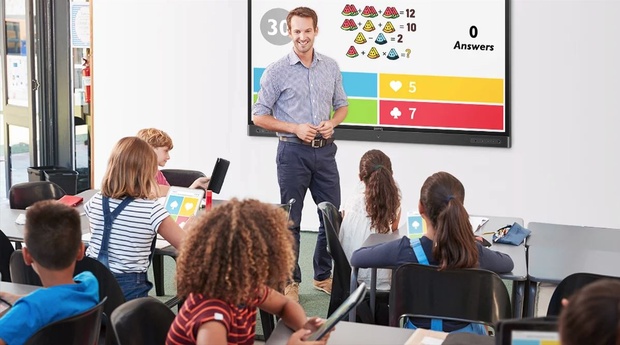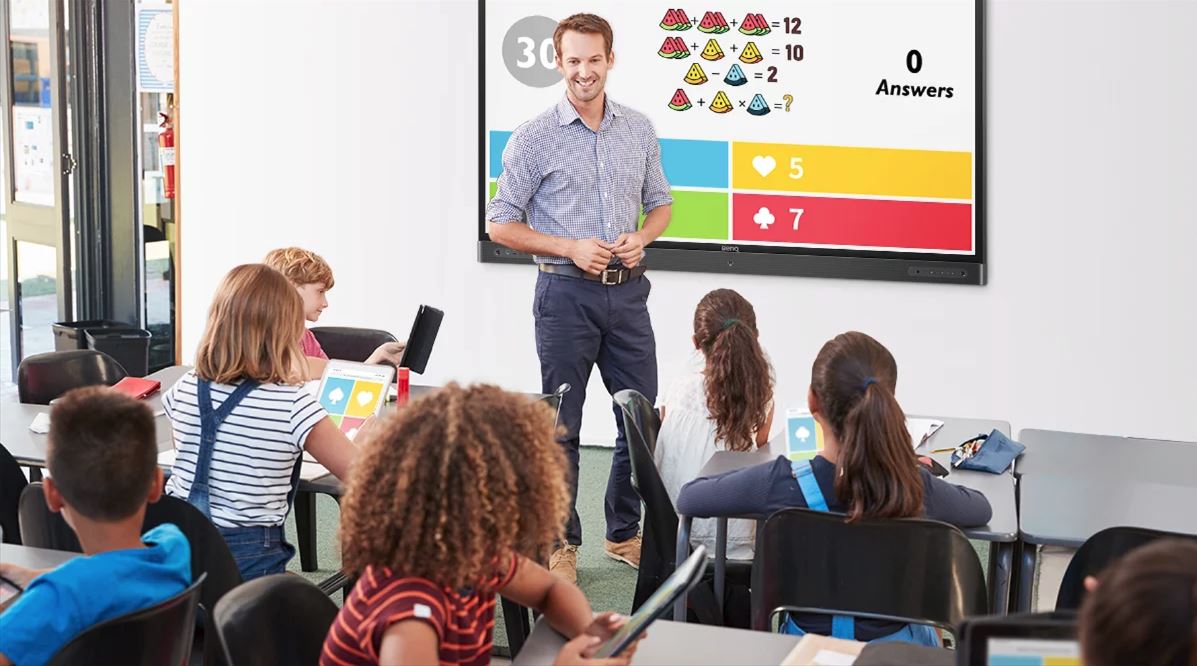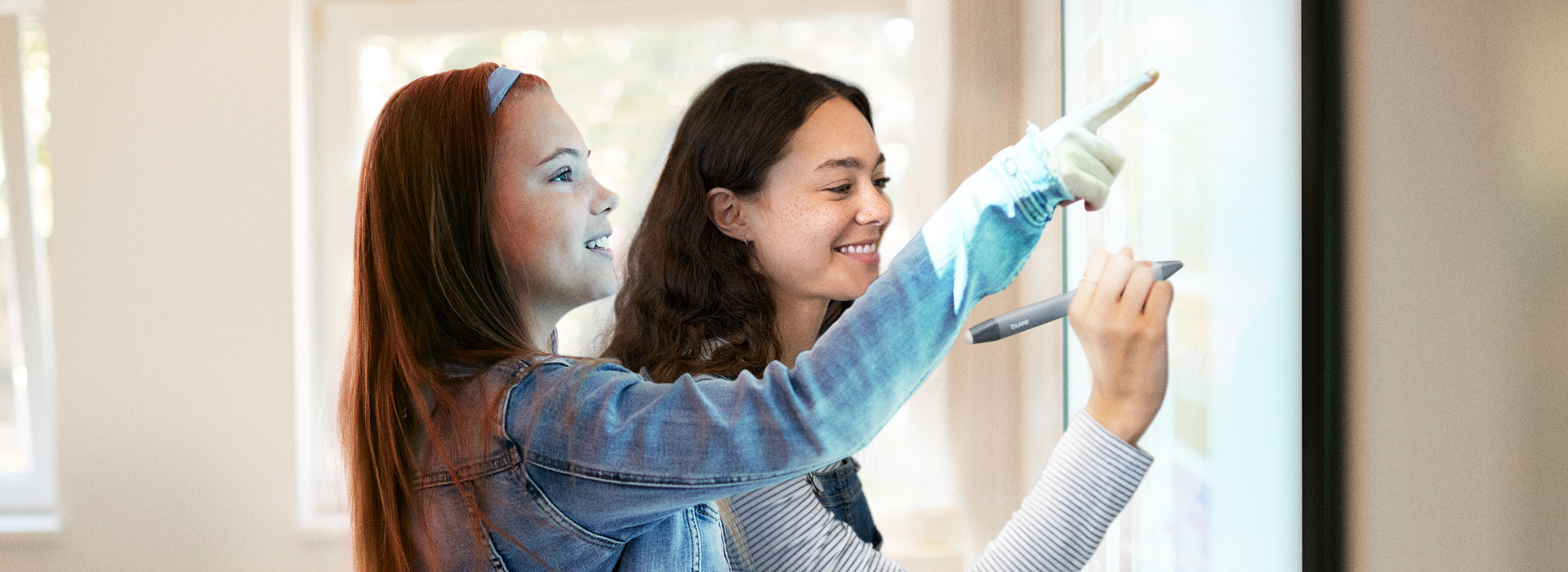Many names exist for the ongoing changes and stages of educational evolution continuing to take place in schools all over Australia. Adapting to new technology and an ever changing set of circumstances, teachers and students are turning to educational technology more than ever to empower flexible, responsive, and adaptable classroom engagement.
“The smart classroom” represents an international trend in learning, a market on track to be worth more than US $300 billion by 2029. Possibly the most effective single-purchase piece of technology schools can add to stay ahead of the curve in 2023 is an interactive display.
Self-contained but widely device agnostic, the interactive display, or interactive board, offers a consolidated central platform to build great smart classrooms. Interactive displays deliver not only an instant upgrade thanks to their all-in-one feature set, they’re also very easy to use and immediately familiar to teachers and students. With students today especially, the learning curve is no longer as steep and scary as it once was, pre “smart” devices and the Tik Tok generation. After all, lengthy training and adaptation very quickly offset the benefits of even the best technology. A good interactive display is ready to go, out of the box and will be, for most teachers, ready to use with only minimal training.
Based on BenQ’s experience and user feedback from K-12 schools all across Australia, we generally observe three stages that help make sure the integration of new educational technology like interactive displays ultimately achieve the most positive learning outcomes.
Stage One: Digitally-Assisted Teaching
This is the primary and entry phase, when educational technology is perhaps still relatively novel to teachers and IT staff. Tech is often used in a “chalk and talk” fashion, with teachers communicating class materials to students in a traditional way, with little feedback from students. Materials are prepared before class, with something like Powerpoint, and technology is utilised as a platform of delivery and presentation. While students may enjoy the audio-visual and multimedia nature of content delivery, this stage is overall mostly passive. An overseas study has shown that students were 1.5 times more likely to fail in a class where lessons were given in a passive manner, as compared to a class with active learning approaches.
Interactive boards offer an excellent progressive teaching tool through this stage. Thanks to their flexibility and ease of use, interactive boards can be used simply or intricately based on educator choice and preference. The ability to directly mirror content from a teacher’s laptop, tablet, or phone onto the display enables the effective sharing of virtually all types of content, from videos to Google Slides presentations.
While many schools are still navigating through this stage, there is a wealth of educational benefits waiting just around the corner.
Stage Two: Interactive Teaching
Taking things to the next level, educational technology becomes invaluably important to extend communication and collaboration among teachers and students. This stage initiates when users become more familiar with technology over time, or are proficient and comfortable with technology from the get-go. Reports have shown that two-thirds of primary school aged children have their own mobile screen based device at home. Since interactive displays are so familiar to many, in most cases classroom users will enter this stage very quickly and start kicking learning goals right away.
With interactive teaching, educators can deliver class materials and activities to all participating students at the same time and with the same level of consistency. The instant delivery offered by interactive displays makes class sessions dynamic and productive, with minimal delays where students would usually take the opportunity to relax their concentration on the task and cause the ever time consuming disruption.
As this stage is reciprocal by nature, it welcomes a lot of interaction and back and forth between teachers and students. Team activities, gamification, Q&A sessions, open discussions and other similar modes of teaching are prevalent in this stage. Students have ample opportunity to receive and provide feedback, plus a plethora of ways to practice presentation skills. Group learning and brainstorming bolster the interactive nature of learning here, all aided by interactive displays.
Thanks to an abundance of Android apps right on the interactive display or mirrored from an external device, classes take on entirely new dimensions compared to basic digitally-aided teaching. Features like multi-touch and split screen encourage learners to approach the board and interact with class materials directly, particularly when working with gamified platforms like Kahoot!, Literacy Planet, Seesaw and many others. Gamified learning has been shown to boost enjoyment and provides instant feedback to the student.
Stage Three: Innovative Teaching in Smart Classrooms
When educational technology like interactive displays truly becomes part of the landscape for teachers and students, the class takes on a whole new way of learning thanks to the “smart” attributes not possible without the implementation of the latest technology.
The scope of learning ability has been ever widening over the last decade, fueled by schools’ digital transformation journey. This means more than just blended or distance learning where students are located beyond the classroom, which helped immensely in the recent pandemic and natural disasters. Imagine the ability to hold extra-curricular activities such as virtual excursions and presentations by guest speakers, all via the cloud and right on the interactive display.
Because this stage offers so many opportunities to enrich the curriculum for students, proficiency levels among educators and learners are very high, and so the technology becomes second nature. Teachers take it upon themselves to explore new topics and try new things with the tools available to them, again with a big emphasis on multimedia content and the cloud.
When teachers and students feel so comfortable with tech that spontaneous adaptation and experimentation occur, you know learning outcomes are in a good place. This stage is the most conducive to open communication, discussions, and knowledge sharing, so this is a common aspiration for most schools, just ask any tech-savvy principal or head teacher.
The most impactful changes that the smart classroom has brought to the Aussie school is the emergence and diversity of new and innovative teaching styles. No longer constrained by one-way communication, genuine multi-group, multi-directional engagement is possible. Collaborative learning is at its peak, and we tend to observe the flipped classroom in action. That is, students explore topics and complete tasks before the class, then discuss what they learned with educators to reach conclusions and share knowledge.
The smart classroom embraces analysis-based learning, where students are encouraged to ask questions and find their own path through tasks while figuring out how to solve problems. Interactive panels form a solid foundation during this stage, thanks to native cloud access, video conferencing, and apps that enable integrated and STEM-based education.
Prepare to Excel
Wherever your school is in these three stages, you probably have or at least have thought about acquiring an interactive board for your classroom or school. Interactive boards have shown and proven the massive potential to revolutionise classroom learning environments with the help of advanced collaboration tools, picking up the digital transformation where the humble iPad left off. However, it’s still important to make sure your school is well prepared for these changes. While the nature of technology, including interactive boards, is to be “plug and play” “out of the box” solutions, there are still considerations and safeguards that need to be put in place. Curriculum that allows for the development of learning structure, strong IT infrastructure and ongoing training and development are the keys to successful implementation. As we venture into 2023, one thing we do know for sure is that interactive displays are now a pivotal and essential part of the modern classroom, and the technology is getting better and better.
With BenQ ClassroomCare® Boards, students and teachers can stay productive and engaged with exclusive and free EZWrite Cloud Whiteboard and InstaShare native screen sharing apps. These enable collaboration and sharing with ease, whether in the classroom or remotely. Advanced healthcare features including World’s First Eyesafe® Certification and Advanced Air Quality Sensors help to ensure safer classrooms. Visit BenQ Education website here.
















